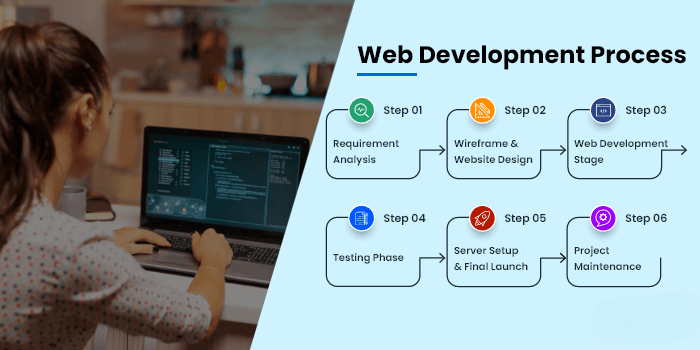Introduction
Web development is a dynamic field that shapes the digital landscape we interact with daily. It encompasses the intricate process of creating and maintaining websites, from initial planning to final deployment and ongoing maintenance. With a blend of creative design, technical expertise, and strategic implementation, web development fuses various disciplines, including design, programming, and testing. This multifaceted process not only crafts visually captivating websites but also ensures functionality, usability, and responsiveness across diverse devices. Moreover, the Web Development Online Training program has been designed to train aspiring professionals in using different skills for effective web development. Thus, in an ever-evolving digital world, web development stands as a pivotal force driving innovation and connectivity across the internet.
This article provides insight into the different procedures involved in Web development. Read this section to know more.
Important Web Development Processes
Web development involves numerous processes that collectively contribute to creating, designing, and maintaining websites.
Here is an overview of some key stages involved in Web Development.
1. Planning and Analysis
- Requirement Gathering: This involves understanding client needs, target audience, and project goals.
- Scope Definition: This step involves defining features, functionalities, and the overall purpose of the website.
2. Design
- Wireframing: Creating a basic layout to visualize the website’s structure is essential for web development.
- UI/UX Design: Furthermore, professionals need to craft user interfaces and experiences for intuitive navigation and appealing visuals.
- Prototyping: This involves building interactive prototypes to showcase design and functionality.
3. Front-End Development
- HTML/CSS: Creating the basic structure using HTML) and styling with CSS is important for the website.
- JavaScript: Furthermore, JavaScript is used for adding interactivity, animations, and dynamic content to the site.
4. Back-End Development
- Server-Side Languages: This step involves using languages like Python, Ruby, PHP, or Node.js to create the server logic.
- Database Integration: In this, databases like MySQL, MongoDB, etc. are implemented to store and manage website data.
- Frameworks and Libraries: Additionally, one must use tools like Express.js, Django, or Flask for efficient back-end development.
5. Testing
- Functional Testing: Web developers must ensure that all features of the web application work as intended.
- Compatibility Testing: This process involves checking compatibility across browsers and devices.
- Performance Testing: Furthermore, web developers need to evaluate site speed, load times, and responsiveness.
- Security Testing: this includes identifying and fixing vulnerabilities to protect against cyber threats.
6. Deployment
- Server Setup: Web developers need to configure servers and hosting environments.
- Domain and Hosting: Additionally, registering domain names and deploying the website on web hosting services is essential.
7. Maintenance
- Bug Fixes and Updates: This step involves addressing issues that arise post-launch.
- Content Updates: In this, one adds new content, features, or functionalities.
- Security Updates: Furthermore, keeping the site secure by applying patches and updates.
8. Optimization
- SEO (Search Engine Optimization): This involves improving visibility on search engines by optimizing content and structure.
- Performance Optimization: It includes enhancing site speed, optimizing code, and improving user experience.
9. Monitoring and Analytics
- Tracking: Tracking can be done using tools like Google Analytics to monitor user behaviour, traffic, and site performance.
- Data Analysis: Lastly, one needs to analyse the collected data to make informed decisions for improvements.
These processes often overlap and iterate, forming an iterative cycle of development. Moreover, collaboration among different teams and continuous learning about emerging technologies are vital for successful web development projects. The field of web development is dynamic and continuously evolving, demanding adaptability and ongoing skill development from its practitioners.
Conclusion
To sum up, the realm of web development involves constant innovation and evolution. As technologies advance and user expectations evolve, the web development landscape continues to expand. Therefore, aspiring Web Development professionals must consider enrolling in the Web Development Course in Delhi to learn various industry-relevant skills. Web development remains an indispensable cornerstone shaping the ever-evolving digital universe and generating greater career scopes.





